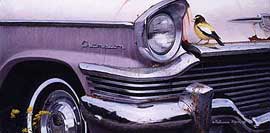
Plate 55 |
|
of course, a great eye for finding and presenting aesthetic qualities. She approached the composition, “in an abstract way, arranging colors and shapes in a long rectangular canvas . . . primed . . . with bright red before painting the picture.” Why? “I’m curious to see if it will get a warm tint as it gets older, as oil paint becomes more transparent as it ages.”[52]
Viewing the Science Landscapes, even unusual ones like this, can convey the dynamic nature of natural contraction and expansion. In this case, the Studebaker Champion is losing more than paint; it is on its way into the history books and the scrap heap. In contrast, the range of the Evening Grosbeak is expanding, and perhaps this makes the bird the new champion. Not only is the bird an excellent aesthetic choice in this painting, it makes biological sense as well. In terms of territoriality, the behavior recorded here is accurate: birds may aggressively defend their territories against perceived intruders, sometimes even confronting reflections of themselves in shiny chrome surfaces. Some viewers might see the narrative as a provocative metaphor for the needs of birds to regain their hold on habitat overrun by the automobile. As Pepin notes, “‘Champion’ tends to remain in people’s minds, and from the reactions and comments they make when they see it, I have a theory that it’s from seeing a car, sacred and venerated in our society, in this state of rustiness.”[53]
<--Return to Examples from the Book
|

